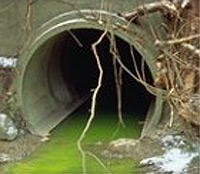
Cultural eutrophication
Encyclopedia

Eutrophication
Eutrophication or more precisely hypertrophication, is the movement of a body of water′s trophic status in the direction of increasing plant biomass, by the addition of artificial or natural substances, such as nitrates and phosphates, through fertilizers or sewage, to an aquatic system...
because of human activity. Due to clearing of land and building of towns and cities, land runoff is accelerated and more nutrients such as phosphates and nitrate
Nitrate
The nitrate ion is a polyatomic ion with the molecular formula NO and a molecular mass of 62.0049 g/mol. It is the conjugate base of nitric acid, consisting of one central nitrogen atom surrounded by three identically-bonded oxygen atoms in a trigonal planar arrangement. The nitrate ion carries a...
are supplied to lakes and rivers, and then to coastal estuaries and bays. Extra nutrients are also supplied by treatment plants, golf courses, fertilizers, and farms.
These nutrients result in an excessive growth of plant life known as an algal bloom
Algal bloom
An algal bloom is a rapid increase or accumulation in the population of algae in an aquatic system. Algal blooms may occur in freshwater as well as marine environments. Typically, only one or a small number of phytoplankton species are involved, and some blooms may be recognized by discoloration...
. This can change a lake's natural food web, and also reduce the amount of dissolved oxygen in the water for organisms to breathe. Both these things cause animal and plant death rates to increase as the plants take in poisonous water while the animals drink the poisoned water. This contaminates water, making it undrinkable, and sediment quickly fills the lake. Cultural eutrophication is a form of water pollution
Water pollution
Water pollution is the contamination of water bodies . Water pollution occurs when pollutants are discharged directly or indirectly into water bodies without adequate treatment to remove harmful compounds....
.
Cultural eutrophication also occurs when excessive fertilizers run into lakes and rivers. This encourages the growth of algae (algal bloom) and other aquatic plant
Aquatic plant
Aquatic plants are plants that have adapted to living in aquatic environments. They are also referred to as hydrophytes or aquatic macrophytes. These plants require special adaptations for living submerged in water, or at the water's surface. Aquatic plants can only grow in water or in soil that is...
s. Following this, overcrowding occurs and plants compete for sunlight, space and oxygen. Overgrowth of water plants also blocks sunlight and oxygen for aquatic life in the water, which in turn threatens their survival. Algae also grows easily, thus threatening other water plants no matter whether they are floating, half-submerged, or fully submerged. Not only does is cause algal blooming, it can cause an array of more long term effects on the water such as damage to coral reef
Coral reef
Coral reefs are underwater structures made from calcium carbonate secreted by corals. Coral reefs are colonies of tiny living animals found in marine waters that contain few nutrients. Most coral reefs are built from stony corals, which in turn consist of polyps that cluster in groups. The polyps...
s and deep sea animal life. It also speeds up the damage of both marine and also affects humans if the effects of algal blooming is too drastic. Fishes will die, there will be lack of food in the area. Nutrient pollution
Nutrient pollution
Nutrient pollution, a form of water pollution, refers to contamination by excessive inputs of nutrient. It is a primary cause of eutrophication of surface waters, in which excess nutrients, usually nitrogen or phosphorus, stimulate algal growth...
is a major cause of algal blooming, and should be minimized.

